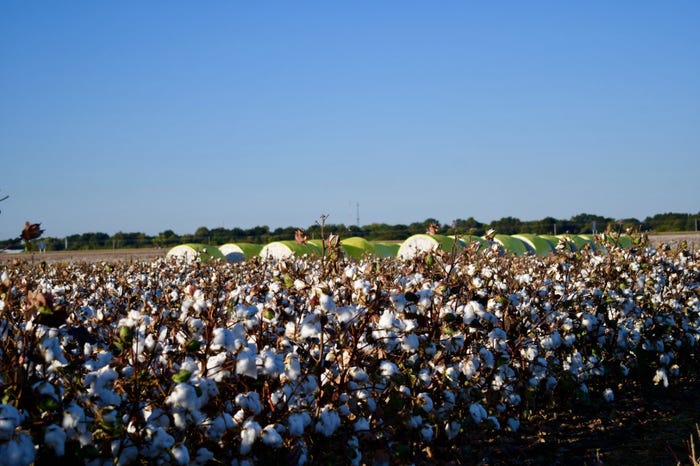
Late summer rains followed the extreme heat of 2022 and left many Arkansas cotton farmers wondering what September had in store. Fortunately, Mother Nature cooperated. As bales rolled in, cotton proved resilient once again.
Bill Robertson, Extension cotton agronomist for the University of Arkansas System Division of Agriculture, attributes the strong finish to an excellent top crop. Ideal temperatures ramped up boll development, and near record-setting yields raise a promising outlook for 2023.
“When looking at yield and fiber quality, the 2022 cotton crop may be one of the best we have had in the state,” he said.
2022 Arkansas Cotton Recap
Good harvest news may come as a surprise with later-than-usual plant dates across the Delta. Robertson explained that the planting windows may have protected the crop from intense summer heat this year.
 Excellent September temperatures made an impact on Arkansas cotton production in 2022. (Whitney Haigwood)
Excellent September temperatures made an impact on Arkansas cotton production in 2022. (Whitney Haigwood)
“Cotton is a tree," he said. ""It shifts into survival mode until better conditions come along, and the crop took advantage of more favorable weather at the end of the season.
“In many cases, plant stress was most noticeable in the lower bolls. Those bolls had fewer seeds than expected, likely caused by the extreme heat. We caught a break with rains in late July and August, and the cotton took off."
Ideal temperatures made a tremendous impact. When fall morning lows drop into the 40s and lower 50s, the crop basically shuts down. Fortunately for Arkansas, that was not the case. Until the very end of the month, September temperatures remained in the 60s. Heat units were stable, and the plants continued to mature bolls.
While farmers were busy harvesting other commodities, cotton waited its turn to round the bases. The dry weather continued, and cotton harvest prevailed. New technology kept the pace as round module pickers rolled into the fields.
“Mother Nature was kind for most during harvest this year. The process was fast and clean. In many cases, bolls went directly into the modules and never saw a drop of rain. Other than scattered showers and few hailstorms toward the end, there was little cotton on the ground due to weather conditions,” he noted.
Robertson reiterated that high yields are also due in part to the boll weevil eradication program.
“Years ago, the top crop would have been taken out by boll weevils. That is no longer an issue, and our top crop hit a home run in 2022,” he added.
When it comes to performance, proven varieties stood out with higher yields.
“For some varieties, everything must work out perfectly for optimum yield. Others are more forgiving and are better at waiting in the field. Several of the racehorses fell back into the pack this year, and we need to keep them in mind for future variety selection.”
The 2022 cotton performance results from the University of Arkansas System Division of Agriculture can be found on the variety testing program webpage.
2023 Cotton Outlook
The Arkansas cotton crop is 99% harvested, according to the USDA National Agriculture Statistics service. The state is estimated to harvest 630,000 acres with a forecasted average of 1,166 pounds lint per acre.
As the crop comes in, quality remains steady. Robertson reported that micronaire discounts are the most common – but have affected only 15% of the bales classed to date. With this trend, he expects to see the same or more cotton acres in 2023.
“It all depends on profitability and how the dust settles in 2022. Budgets for 2023 are under development now, and it looks like cotton producers will cover their expenses with 1,200 pounds lint per acre cotton,” he projected.
Robertson added that inflated input costs and availability will determine how farmers manage their acres next year.
“Bottom line, we cannot afford to continue doing what we have always done. Farmers will have to look at where to cut costs. We must focus on getting the biggest bang for our buck,” he added.
The management between crops may also factor into next year’s cotton acreage. In comparison to corn, cotton requires half the nitrogen and half the irrigation. Plus, it is more adaptable in extreme growing conditions.
“With corn, you really have one shot to get it right. If the weather does not cooperate, the corn crop tends to take it on the chin as it did for many in 2022,” he said.
Another piece of the puzzle may lie in investments. Many Arkansas farmers bought or upgraded machinery when they took on additional cotton acres, including pickers for harvesting. Those expenditures could potentially keep the state’s cotton acreage up in 2023.
About the Author(s)
You May Also Like






